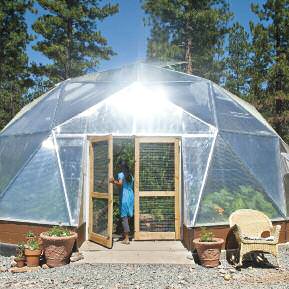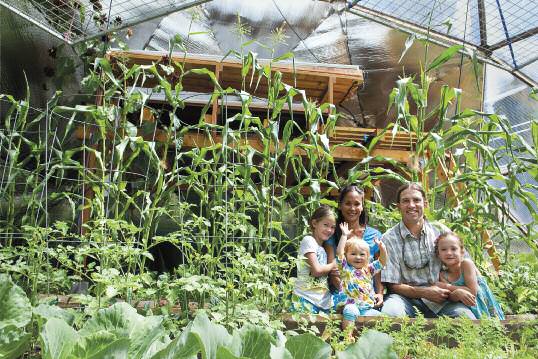community gardens
MOUNTAIN GROWN
Truckee’s geodesic growing dome offers edibles year-round.
WRITTEN BY SUSIE SUTPHIN
PHOTOS BY CANDICE NYANDO
As community members across the country become more focused on their food security (not only as a way to improve access to ecologically grown food, but also to improve their local economy), they must evaluate their foodshed. Discerning local food enthusiasts should look at where their food is sourced but, more importantly, how food can be grown in their region.
Thanks to special growing structures and four-season growing methods, even those living in mountain climates now can grow food. These special growing structures aren’t just ordinary greenhouses; they are geodesic dome-shaped greenhouses manufactured by Udgar and Puja Parsons of Growing Spaces in Pagosa Springs, Colo.
| The Kelly family (from left, Kailea, 8; Jennifer; Keva, 1; Bill; and Lylah |
Udgar Parsons was working for Aspen’s Windstar Foundation in 1985 when he first learned about this structure and made a proposal that he could design a growing dome that regular folks could afford. Four years later, he founded Growing Spaces and moved his business to Pagosa Springs, Colo., in 1995. At the time, Growing Spaces’ structures were the first growing domes. Now there are more than 80 in the greater Pagosa area, making it the nation’s mecca for geodesic greenhouses. This is more than just an impressive number; it demonstrates a mountain community’s ability for self-reliance and to grow its own food year-round.
Blooming Potential
Only a handful of domes exist in Nevada and California, but word is spreading. A couple of years ago, Deb Kelly of Kelly Brothers Painting in Truckee was tipped off to Growing Spaces’ ventures.
“As soon as I saw the Growing Spaces website, I knew a dome would be in our family’s future,” she says. “From the hexagonal design to the shear energy of the space, this structure affirmed to me it would be an abundant garden for our family and community.”
At the time, Deb’s son, Bill Kelly, had been researching traditional greenhouses and even had applied for a USDA grant to build a community-size greenhouse.
When the USDA grant fell through, Bill’s aspirations for a Truckee Community Farm seemed dashed. He had hoped a greenhouse would serve as a demonstration site for four-season growing; supply area schools with local, organic food; and supplement food distribution at North Lake Tahoe’s hunger relief agency Project MANA. When Deb showed her son the growing dome, he had found a greenhouse that he could afford and still fulfill his dreams.
“I felt the urgency to bring one of these domes to Tahoe and share with everyone the possibility of growing in the mountains,” he says. “I didn’t want to wait for another grant, so we decided to fund it ourselves.”
Giving Back
As the Kelly Brothers Painting business has grown, the Kellys have made a point to give back to the community. During the past few years, food access — especially for those less fortunate — has become an increasing concern for the Kellys. And the growing dome provides a direct way to address this issue.
The Kelly dome was built in October 2011 and first seeds were planted in early March 2012. By the second week of April, volunteers already were harvesting 12 pounds of vegetables and beginning to make donations to Project MANA. There is a reason they call it a growing dome because plants thrive in there.
The dome sits on the property of Kevin Kelly, Deb’s other son and Bill’s brother. It is happily situated on a sunny hillside in Truckee’s Glenshire neighborhood. Kevin has two sons, Gaven and Miles, who have taken an affinity to the dome, coming down to help me, the author and dome manager. Gaven is the older brother and at the green age of 10 years old, already is able to handle daily chores, watering the seedlings and harvesting vegetables, when I was out of town.
 |
| Jennifer Kelly walks into the Grow Dome |
Unlike a traditional greenhouse, the curved surface of a growing dome ensures even heat input throughout the day, allowing the dome to capture more hours of sunlight. The geometric shape strengthens the dome’s structural integrity, allowing wind to flow over it (versus against it) and it naturally sheds snow. This makes it ideal for Lake Tahoe’s harsh winter and heavy snow loads. Many rectangular greenhouses use a single- or dual-wall siding. The growing dome uses a glazed, five-wall, polycarbonate panel, which is not only strong but also diffuses the light and provides the plants UV protection.
The way the dome regulates its temperature is just as extraordinary as its shape. Employing a water tank that is scaled appropriate to the size of the dome, the water acts as a thermal mass, capturing the sun’s heat and expelling it at night to maintain the dome’s temperature. A Mylar shield on the north side of the dome’s interior deflects low, winter sun into the water tank. In summer, the Mylar shades the tank, helping to keep the dome cool. Insulated side walls and pipes that run through the garden beds pump warm air in winter and cool air in summer, working together to help keep the soil at an optimum growing temperature. The best part is that the dome is fully off the grid, using solar panels to run the pumps and fans.
For details about the growing domes (that come as a kit in five sizes), visit www.Growingspaces.com. To learn more about the Kelly Brothers’ project, visit www.Kellybrotherspainting.com. To schedule a tour of the growing dome at the Truckee Community Farm, use the contact page at www.Tahoefoodhub.weebly.com.
Susie Sutphin lives in Truckee, Calif., where she is the farm manager for the Kelly family at their growing dome. When not learning more about organic growing, she dreams big about building a Tahoe food system with regional food producers. Learn more about her and ideas on sustainability by visiting her blog at www.Foodchronicles.net.


